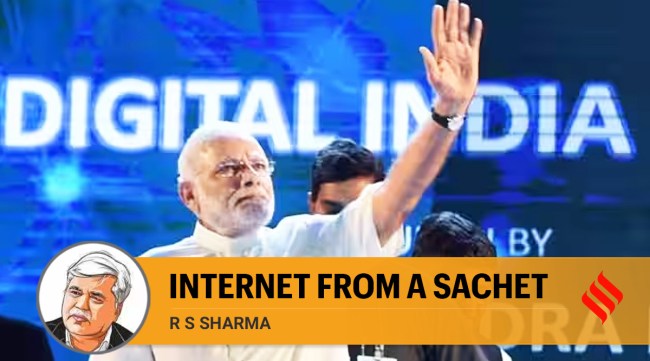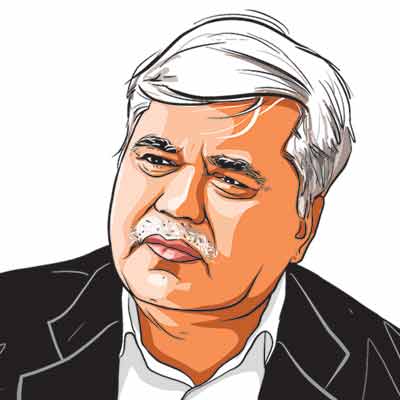Opinion Wi-fi hotspot pouches: Internet from a sachet
Distributed through PMWANI, it can be a game changer in digital connectivity.
 This system can provide community content without using the bandwidth. The idea was successfully piloted and submitted to the Department of Telecom (DOT) as the Wi-Fi Access Network Interface, or WANI, in March 2017. (Express File Photo)
This system can provide community content without using the bandwidth. The idea was successfully piloted and submitted to the Department of Telecom (DOT) as the Wi-Fi Access Network Interface, or WANI, in March 2017. (Express File Photo) The Digital India programme has three main vision areas: Digital connectivity, software and services on demand and digital empowerment of citizens. Digital connectivity is a sine qua non for everything digital in today’s world. Fortunately, the connectivity landscape has been transformed in the last seven years due to multiple factors like the boom in mobile telephony (a billion-plus mobile connections), 4G coverage, a significant reduction in tariffs (from Rs 300 per GB to a mere Rs 7 per GB) and increased smartphone penetration.
Enabling policies like Net Neutrality and the country’s focus on building Digital Public Infrastructure (DPI) — particularly digital ID and UPI — have further contributed to the increase in digital transactions across domains. However, this growth has been accompanied by a huge surge in data demand. Video is now the major data-guzzling medium. India’s per capita data consumption is a whopping 19.5 GB per month and the total data volume transported by mobile networks of India is more than the mobile networks of the US and China combined.
This means that today, even a child requires five to six gigabytes of data for online classes and other educational requirements. Thus, the gap between demand and affordable supply remains wide, especially for poor households and rural India. How does one address this situation?
The creation of inter-operable public wi-fi hotspots was one such idea proposed by the Telecom Regulator of India (TRAI) in 2017. Similar in concept to the PCOs of the past, it proposed to create millions of interoperable wi-fi hotspots, Public Data Offices (PDOs), for the last mile distribution of broadband to the common people in sachet-sized packages of Rs 5 to 10. This system can provide community content without using the bandwidth. The idea was successfully piloted and submitted to the Department of Telecom (DOT) as the Wi-Fi Access Network Interface, or WANI, in March 2017.
As usual, there was opposition to the idea and the Cellular Operators Association (COAI) gave a commitment to the government that there was no need for WANI, and they will create a million hotspots within a year. Nothing was done.
It took three years for the DOT to approach the Union Cabinet and the same was approved in December of 2020 as PM-WANI. The Cabinet’s approval was truly transformational. No licence or permit was needed for operators to start operations. Several start-ups who had participated in the initial pilot began the work. Then Covid-19 struck, and work came to a grinding halt. Now, the operators, PDO Aggregators (PDOAs), have resumed working.
One of the arguments against PM-WANI is that data is now so cheap and everyone has 4G connectivity — there is no business case for wi-fi hotspots. This, as we have seen, is an oversimplification.
A very positive wind has started to blow — albeit at a very small scale and in some isolated pockets of the country. In the last year alone, more than 1.5 lakh wi-fi hotspots have been installed by PDOAs and more than a million people are getting unlimited Internet daily by paying just Rs 5 to 10. Students are buying this sachet internet instead of a packet of chips or soft drinks from their pocket money.
By introducing various entities such as PDO, PDOA, app providers, and a central registry, a truly open and scalable framework has been created. Like UPI transformed the financial space in India, something similar has started to happen in the internet connectivity space. PM WANI is poised to become a unique digital public infrastructure.
This framework offers a compelling business opportunity for aggregators as it allows unbundling of internet distribution at the last mile, eliminating the need for additional licencing fees. This proposition is particularly exciting as it provides a robust foundation for delivering affordable internet access to a significant portion of society. Currently, India’s home broadband penetration stands at one of the lowest in the world, hovering at around 10 per cent. PM-WANI presents a golden opportunity to accelerate high-speed unlimited internet penetration, bridging the digital divide and empowering communities.
PM-WANI can also nurture the growth of local nano entrepreneurs throughout the country. These last-mile providers (PDOs) can be found in small shops, local establishments, and even households. They establish wi-fi hotspots and offer internet access to other users, enabling them to augment their monthly earnings while promoting internet usage through affordable sachet plans.
The flexibility of this framework empowers aggregators (PDOAs) to capitalise on the internet distribution space, without the burden of additional licencing fees. Their primary role involves providing authorisation and accounting services to PDOs, ensuring a seamless and secure user experience.
Although infrastructure laid out by major companies like RailTel and GAIL already exists, it is currently underutilised. Moreover, many large Internet Service Providers (ISPs) are hesitant to enter underserved areas. This situation presents a golden opportunity for the PM-WANI framework to flourish. By offering a cost-effective and reliable solution, it represents a beacon of hope for people in underserved areas. It also benefits Internet Service Providers (ISPs) and Telcos as they end up selling more bandwidth by making their end customers retailers.
PM-WANI needs to be promoted by all stakeholders — governments, civil society, and startups. This Digital Public Infrastructure (DPI) is uniquely Indian in its approach to interoperability, openness, and scalability. It will hopefully accelerate like UPI or other DPIs.
The writer is former chairman of TRAI. Views are personal



